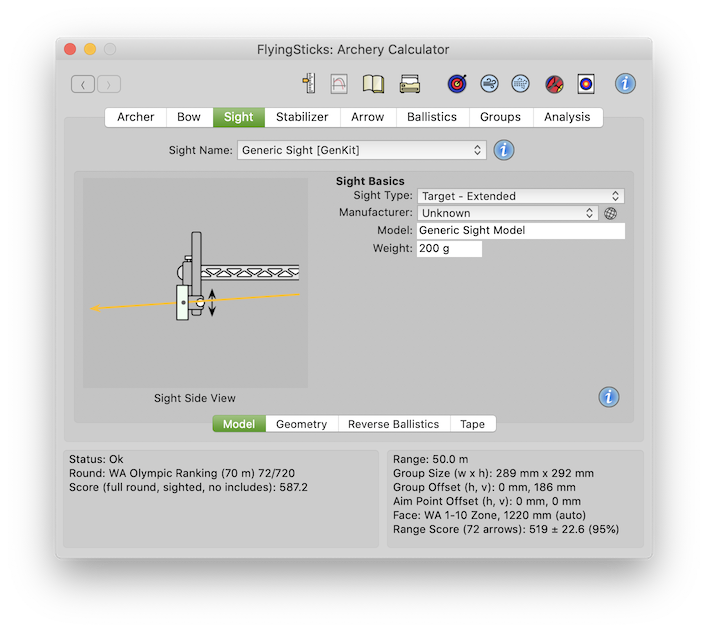Select the type of sight from the drop down list. Assists in geometry and stabilizer calculations. When the sight type is changed, various parameters can be modified to suit the new sight. These include the tape style and length, length, the sight scale multiplier, the number of sight pins and the maximum tape range. Before changing the sight type, it is often desirable to first save the current sight and introduce a new sight in the Sight Name field.
The Sight Type will also control the visibility additional data fields and buttons when required.

Select the manufacturer's name. Presently for documentation purposes only.

Go to manufacturer's web site if you are connected to the internet. Will open in the default browser.
Enter model details or brief description.
Enter the mass of sight. Used in bow stability calculations.
This section is made visible only when one of the clout sight types is
selected in the "Sight Type" drop-down menu. Assumes a prism or periscope
attachment has been added to a standard sight that allows the true sight
point to be kept well above the arrow's axis.
See the Clout Ballistics Optimization section in the Ballistics>Clout panel for more details.
The angle that the attached clout sight deviates the sight-line downwards. Usually in the 4° to 15° range for prism or 4° to 35° for periscopes.
The height offset that periscope mirror offsets the sight-line. Typically about 50 mm, with a positive value implying above sight-line. Defaults to 50 mm. Only visible for periscope sights.
This section is made visible only when a pendulum sight type is selected in the "Sight Type" drop-down menu. With pendulum sights, the sight barrel hangs below a dampened pivot point, such that when the bow is pointed down the sight pin moves away from the arrow axis, partially compensating for the low elevation trajectory. Some pendulum sights allow the pendulum to be locked, turning the sight into a conventional single or multi pin type.
When entering general sight data, it is assumed the target and archer are at the same height, as for other sight types.
The distance between the pendulum pivot and the top pin of the sight.
See Pivot Sights above for a description of the other measurements.
Note: presently FlyingSticks allows the selection of Pendulum sight types, but the geometry of these sights is not yet fully supported.
This section is made visible only when a pivot sight type is selected in the "Sight Type" drop-down menu. It is assumed the pivot sight had a mechanical parallelogram action that keeps the sight tube at a constant angle relative to the arrow axis.
The dimensions below are indicated on the adjacent diagram.
The pivot length (P) is the distance between the horizontal pivots of the parallelogram mechanism.
The arm length (A) is the distance between the rear pivot point and the sight scale surface or pointer.
When the pivot sight parallelogram is set to a rectangle (i.e. with right-angled corners), the "Right-Angle Pin Height" (H) is the distance between the pin and the arrow center line. This parameter is required to make the small correction for the non-linear scale to pin height translation. Note that most manufacturers try to ensure this error is minimal for a normal setup - i.e. small enough to ignore, but that depends on the precision being sort.
The scale factor is the ratio of the scale length to the corresponding sight-pin movement. For the pivot mechanism it is the ratio of the effective lengths of the lever arms:
(pivot length (P)) / (scale arm length (A))
If the scale is on the opposite side of the pivot to the sight point, then the scale will be inverted, so the scale multiplier should be negative. For example, the author's TruGlo Range Rover's scale multiplier is -1.571.
This section is made visible only when a dial sight type is selected in the "Sight Type" drop-down menu.
The scale factor is the ratio of the scale length to the corresponding sight-pin movement. For the dial mechanism this will depend on gear ratios or other factors. The manufacturer may provide the figure or it can be measured directly.
Primarily for hunting sights, the sight barrel is locked in position, and each pin is allocated a range. This section is made visible only when a multi-pin sight type is selected in the "Sight Type" drop-down menu.
Enter the number of pins. Note, a multi-pin sight with one pin is valid, but it is assumed the pin's position is fixed.
Defines the diameter of the barrel disc in multi-pin templates. At present, has no other function.